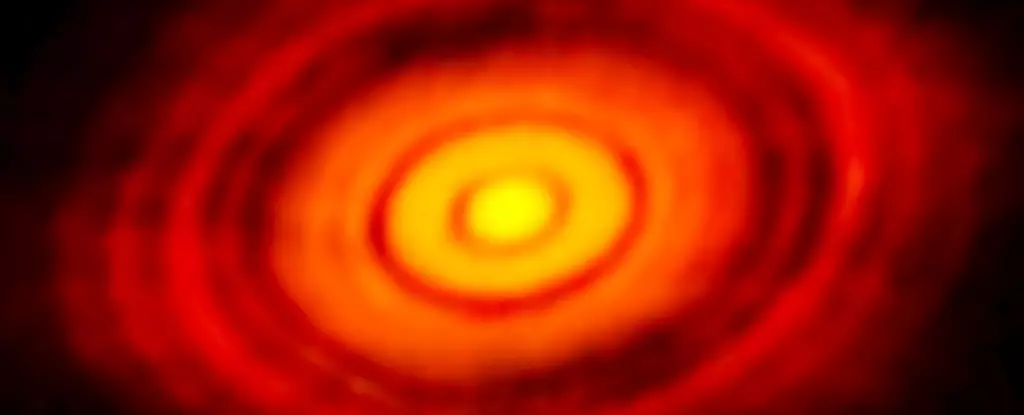The formation of planets has long been a topic of fascination for scientists and astronomers alike. However, recent research using the Atacama Large Millimetre/submillimetre Array (ALMA) has challenged our understanding of this process. New observations presented at the American Astronomical Society’s 243rd Meeting suggest that planet formation around young stars may begin much earlier than previously thought. This article delves into the surprising findings and their implications for our understanding of the universe.
ALMA’s early observations of young protoplanetary disks have provided invaluable insights into the formation of planets. These disks, which surround young stars, exhibit rings and gaps that scientists believe to be potential formation sites for planets. Previous images captured with ALMA predominantly featured Class 2 disks, which indicate relatively older stars. However, the new images from the CAMPOS survey showcase Class 0 and Class 1 disks, associated with younger stellar objects (YSOs).
The presence of rings and gaps in the disks around these exceptionally young stellar objects is a truly astonishing revelation. YSOs classified as Class 0 are still in the collapsing and formation stages, while Class 1 objects are only a few hundred thousand years old. These findings challenge our previous assumptions about the timeline of planet formation and raise questions about the fundamental processes involved.
Scientists have proposed two primary theories to explain the formation of planets: core accretion and gravitational instability. In the core accretion model, rocky cores form from the collision of planetesimals. Once these cores reach a sufficient mass, they attract a gaseous envelope, potentially resulting in the formation of gas giants like Jupiter. On the other hand, the gravitational instability theory suggests that a protoplanetary disk reaches a critical mass, leading to the formation of gravitationally bound clumps that later give rise to planets.
The newly obtained images present a challenge to the core accretion model of planet formation. According to Cheng-Han Hsieh, a Ph.D. candidate at Yale, it is difficult to form giant planets within a million years through core accretion. This discrepancy prompts a reevaluation of our current understanding of how planets come into existence. The early formation of rings and gaps in the protoplanetary disks around YSOs suggests that the journey toward planetary formation begins earlier than anticipated.
The angular resolution of ALMA presents certain limitations in detecting substructures within protoplanetary disks. Hsieh explains that the current resolution can only detect rings and gaps larger than 8 astronomical units (AU). To put this into perspective, the distance between the Sun and Saturn is approximately 9 AU. Consequently, substructures smaller than this limit remain undetectable. It is important to consider this limitation when analyzing the absence of substructures in the earliest systems.
Determining whether the observed substructures indeed signify planet formation or stem from other instabilities remains a challenge. While simulations suggest that the presence of Earth-sized or Neptune-sized planets can result in the creation of gaps and rings, various instabilities related to density and temperature can also produce similar patterns. Therefore, as Hsieh concurs, it is challenging to definitively attribute the observed substructures to planet formation based solely on observations.
Despite the uncertainty surrounding their origin, the presence of gaps and rings within protoplanetary disks holds immense significance. The substructures indicate that the disk has reached a stage where turbulence subsides and the formation of structures and planets becomes possible. The exact timeline of when these substructures form is of great importance, as it provides valuable insights into the overall process of planet formation.
While the recent observations shed light on the early stages of planet formation, further research and observations are necessary to confirm the nature of the substructures. A paper detailing these images and their implications is currently being prepared for publishing. Only future observations will enable us to definitively ascertain if the structures captured in the images are indeed planets or transient features destined to fade away as the planetary system evolves.
The ALMA observations of protoplanetary disks have unveiled a startling revelation – planet formation may begin much earlier than anticipated. The presence of rings and gaps in the disks surrounding remarkably young stellar objects challenges our current understanding and theories of planet formation. By pushing the boundaries of our knowledge, these findings pave the way for further exploration and research into the mysteries of the universe. As scientists continue to unravel the complexities of planet formation, we inch closer to comprehending the wonders of our own solar system and the countless others that fill the cosmos.


Leave a Reply